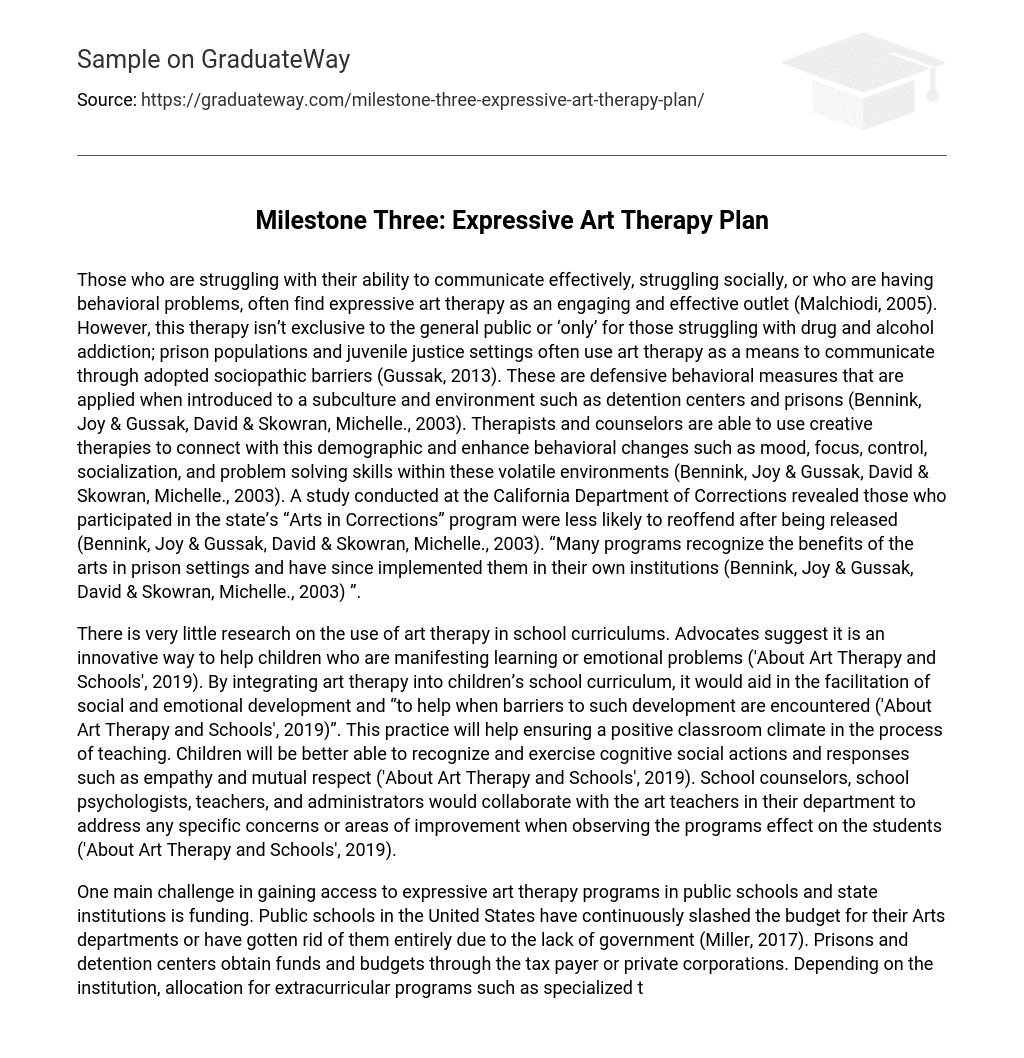Those who are struggling with their ability to communicate effectively, struggling socially, or who are having behavioral problems, often find expressive art therapy as an engaging and effective outlet (Malchiodi, 2005). However, this therapy isn’t exclusive to the general public or ‘only’ for those struggling with drug and alcohol addiction; prison populations and juvenile justice settings often use art therapy as a means to communicate through adopted sociopathic barriers (Gussak, 2013). These are defensive behavioral measures that are applied when introduced to a subculture and environment such as detention centers and prisons (Bennink, Joy & Gussak, David & Skowran, Michelle., 2003). Therapists and counselors are able to use creative therapies to connect with this demographic and enhance behavioral changes such as mood, focus, control, socialization, and problem solving skills within these volatile environments (Bennink, Joy & Gussak, David & Skowran, Michelle., 2003). A study conducted at the California Department of Corrections revealed those who participated in the state’s “Arts in Corrections” program were less likely to reoffend after being released (Bennink, Joy & Gussak, David & Skowran, Michelle., 2003). “Many programs recognize the benefits of the arts in prison settings and have since implemented them in their own institutions (Bennink, Joy & Gussak, David & Skowran, Michelle., 2003) ”.
There is very little research on the use of art therapy in school curriculums. Advocates suggest it is an innovative way to help children who are manifesting learning or emotional problems (‘About Art Therapy and Schools’, 2019). By integrating art therapy into children’s school curriculum, it would aid in the facilitation of social and emotional development and “to help when barriers to such development are encountered (‘About Art Therapy and Schools’, 2019)”. This practice will help ensuring a positive classroom climate in the process of teaching. Children will be better able to recognize and exercise cognitive social actions and responses such as empathy and mutual respect (‘About Art Therapy and Schools’, 2019). School counselors, school psychologists, teachers, and administrators would collaborate with the art teachers in their department to address any specific concerns or areas of improvement when observing the programs effect on the students (‘About Art Therapy and Schools’, 2019).
One main challenge in gaining access to expressive art therapy programs in public schools and state institutions is funding. Public schools in the United States have continuously slashed the budget for their Arts departments or have gotten rid of them entirely due to the lack of government (Miller, 2017). Prisons and detention centers obtain funds and budgets through the tax payer or private corporations. Depending on the institution, allocation for extracurricular programs such as specialized therapy or counseling is not a high priority for most budgets (Miller, 2017). Another challenge is reaching specific communities and economically devastated communities. Rural public schools tend to be underfunded and while urban communities suffer under socioeconomic disadvantages like unemployment, school dropout rates, and high crime rates (‘About Art Therapy and Schools’, 2019). Again, allotting funds to these specific areas is not generally at the top of the list for state government budgeters or the U.S Department of Education (Miller, 2017). Most research done in expressive art therapies is qualitative and discusses clinical observations, case examples, and the process of application. With an increase of recognition by mental health professionals, there has been a growing awareness in the value of expressive modalities involving the use of this specific treatment (Malchiodi, 2005). The interest of conducting or participating in research, particularly in the areas of trauma, attention-deficit/hyperactivity disorder, autism, and dementia is becoming a respected commodity in some professional portfolios (Malchiodi, 2005). With this peak in information, more opportunities to introduce mental health wellness practices in the workspace or education system will be available, particularly for interventions (Malchiodi, 2005). Many expressive therapies are considered by the National Center for Complementary and Alternative Medicine to be “mind–body interventions” due to the duel mix of psychotherapy and therapies that capitalize on the aesthetics reaching the senses (Malchiodi, 2005).
References
- About Art Therapy and Schools. (2019). Smhp.psych.ucla.edu. Retrieved 10 February 2019, from http://smhp.psych.ucla.edu/pdfdocs/arttherapy.pdf
- Bennink, Joy & Gussak, David & Skowran, Michelle. (2003). The role of the art therapist in a Juvenile Justice setting. Arts in Psychotherapy – ART PSYCHOTHER. 30. 163-173. 10.1016/S0197-4556(03)00051-0.
- Gussak, D. (2013). Art Behind Bars. Psychology Today. Retrieved 10 February 2019, from https://www.psychologytoday.com/us/blog/art-trial/201310/art-behind-bars
- MALCHIODI, C. (2005). Expressive Therapies History, Theory, and Practice. Psychologytoday.com. Retrieved 10 February 2019, from https://www.psychologytoday.com/files/attachments/231/malchiodi3.pdf
- Miller, H. (2017). U.S. Students Are Struggling In The Arts. Donald Trump’s Budget Would Make The Problem Worse.. HuffPost UK. Retrieved 10 February 2019, from https://www.huffingtonpost.com/entry/us-students-struggling-arts-and-donald-trump_us_58ff678be4b0c46f0782711b





